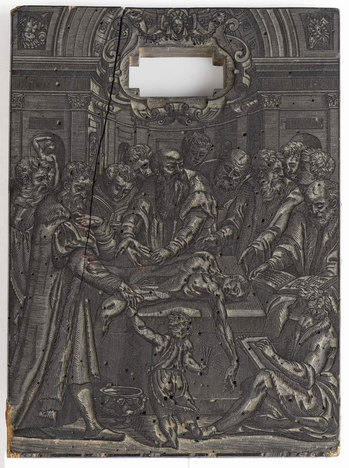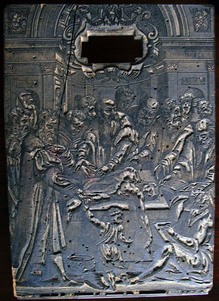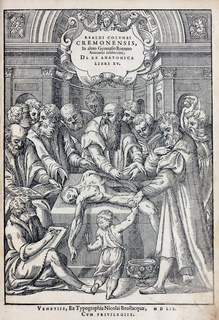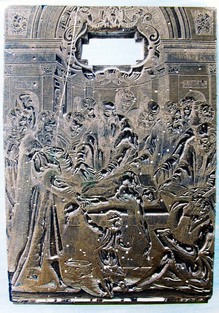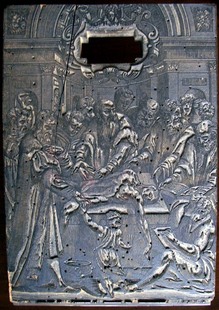Realdo Colombo (ca. 1510-1559), Original woodblock for the frontispiece of Colombo’s De re anatomica libri XV (Venice: Vincenzo Valgrisi for Nicolai Bevilacqua, 1559). Pearwood block (291 x 205 mm), with cartouche cut-out at top for the title type inset. Purchased with funds donated by Ronald A. Brown, Class of 1972; G. Scott Clemons, Class of 1990; Dr. Eugene S. Flamm, Class of 1958; Professor Joshua T. Katz; Professor James H. Marrow; Vsevolod A. Onyshkevych, Class of 1983; Dr. Robert J. Ruben, Class of 1955; Mark S. Samuels Lasner; Terry I. Seymour, Class of 1966; W. Allen Scheuch II, Class of 1976; Bruce C. Willsie, Class of 1986; an anonymous donor; the 75th Anniversary Fund of the Friends of the Princeton University Library; and funds from the Princeton University Library. Graphic Arts GAX 2011- in process
We have acquired the original woodblock for one of the most famous frontispieces in renaissance medical literature and Colombo’s only published work. In 1543, Colombo assumed the position held by Andreas Vesalius (1514-1564), as professor of medicine at the University of Padua and the imagery for Colombo’s frontispiece is a direct reference to the frontispiece of Vesalius’s De humani corporis fabrica libri septem (1543). The scene also has much in common with Donatello (ca. 1386-1466), The Heart of the Miser, in the arrangement of the students and the dangling arm of the cadaver: http://www.shafe.co.uk/crystal/images/lshafe/Donatello_ Miracle_of_ the_ Misers_ Heart_1450.jpg
Ruth Mortimer writes, “The names of Titian and [Giuseppe Porta] Salviati have been mentioned in connection with this cut. Titian, as a friend of Colombo’s. Salviati, by comparison with the title block that he designed on a similar scale for Marcolini’s Sorti in 1540. Salviati was further associated with Marcolini in 1552 and possibly 1556, and Bevilacqua was successor to Marcolini’s press.”
The suggestion that Titian (ca. 1488-1576) may have designed this frontispiece is not surprising, as the artist had many links with the world of Venetian publishing and was known to collaborate with block cutters in the production of prints, such as his vast multiblock Submersion of Pharaoh’s Army and his dynamic Saint Jerome in the Wilderness. In fact, it was one of his students, Jan Steven van Calcar (ca. 1499-ca. 1546), who designed the woodcuts for Vesalius’s anatomy book.
However, the artist, whoever he was, would have known that he was second choice, since the book was meant to have been a collaboration between Michelangelo Buonarroti (1475-1564) and Realdo Colombo.
In 1548 Colombo moved to Rome and wrote to Duke Cosimo I de’ Medici to explain that he wanted to “pursue my dissections and supervise the painters.” He also mentioned his collaboration with the “greatest painter in the world” on a proposed book of anatomy. The work alluded to would be the De re anatomica libri XV, and the painter was Michelangelo, who planned to design the illustrations. Sadly, Michelangelo never completed the designs and Colombo died during the printing of his only book.
According to Andrea Carlino (“The Book, the Body, the Scalpel: Six Engraved Title Pages…,” RES, Anthropology and Aesthetics [1988]), the extant frontispiece offers several references to the intended collaboration. The doctor performing the dissection is unquestionably Colombo, and the man to the right (left in the block), taking the hand of the putto, bears a resemblance to numerous portraits of Michelangelo. The man with the book might be Vesalius with his Fabrica, which Colombo is trying to correct with this volume. The young artist on the floor might refer to whoever took over after Michelangelo.
Richard Lan writes, “For aesthetic as well as commercial motives, frontispieces in sixteenth-century books were objects of considerable importance, and significant effort and expense were lavished on them on the part of publishers: their two-fold purpose was to summarize the contents of the book in a graphically striking way, often with an allegorical element or a ‘concetto’ in the manner of an emblem book, and to ‘sell’ the book. In sum, illustrated title-pages frequently represent the summit of the graphic arts in the printed book, and have been so acknowledged in several exhibitions and anthologies.”
